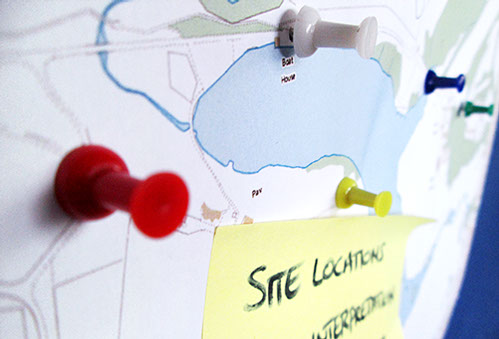But where do we begin? Firstly we must understand interpretation planning is a process, and like all journeys fraught with misdirection, temptations and distractions, if we stray off the path we will never reach our destination (well, not the one we were originally heading for anyway!).

One of the first stages of developing an interpretation plan is to take stock of the resources that we have to work with. These would include:
- The physical resource presented by the fabric and features of the site.
- The cultural resource presented by the human associations of the site and its surroundings.
- The human resource, which includes the people who will be involved in the development and delivery of the interpretation projects.
The next stage in the planning process is to analyse who our visitors are and what needs and aspirations they have. These might include:
-Retired people
– G Families with young children
– Tourists / holiday makers
– Regular repeat visitors / local residents
Activity interests:
– Walkers (including dog walkers)
– Golfers
– Horse riders
– Orienteering
– Fun runs / cross-country runners
– Cyclists / mountain bikers
- Specialist:
– Natural history
– People visiting other local attractions
- Organised groups:
– Schools
– Coach parties (tend to be retired people)
– Special needs groups
– Adult education groups
We must now develop a set of interpretive themes to draw out what is special and distinctive about our site. These are the main messages that should be presented to visitors to help them to understand and appreciate the physical and cultural heritage resource.
A key stage in interpretation planning is to describe a set of interpretive objectives to clearly define why interpretation should be provided at a site and what it should aim to achieve. They can be used as a baseline to evaluate the effectiveness of the interpretation. Interpretive objectives are generally split into four categories.
Learning Objectives
Interpretation can help people of all ages to learn in an enjoyable and involving way. This in turn can provide an avenue to understanding and appreciating the importance of the physical, cultural and natural heritage associated with the site.
Behavioural Objectives
Interpretation has the capacity to influence people’s actions, not only while they are visiting but also after they have left.
Emotional Objectives
To be effective, interpretation should strive to make people think, react, care and even become involved at some level.
Economic Objectives
By enhancing the experience of a visit, visitors should be encouraged to explore further, stay longer, use local facilities, return and recommend a visit to others.
Gathering information is often the easy part, it is after all simply fact finding and requires no creative thinking. To take our project forward to a successful conclusion we must understand the definition of interpretation:
- It reveals the meaning of places, things, people and events
- It provokes and stimulates thought
- It encourages people to relate to the sense of place
- It encourages exploration
- It adds to enjoyment and is memorable
Once you have done all this it is on to the fun part; the development of storylines, illustrations, interpretive media, events and launch parties! But that’s a blog for another day.
Good luck with your interpretive project and if you need a hand you know where we are.











